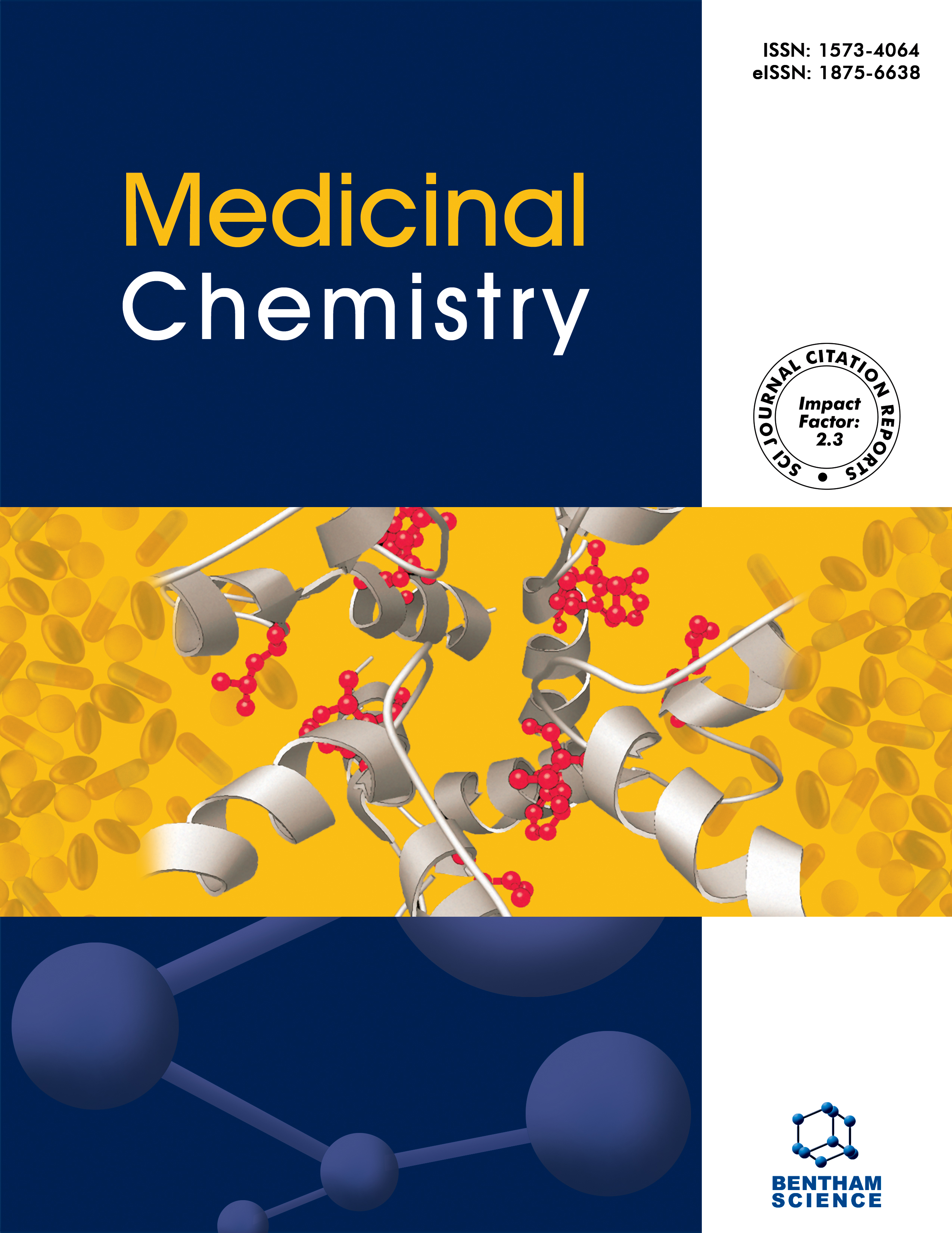- Home
- A-Z Publications
- Medicinal Chemistry
- Previous Issues
- Volume 6, Issue 3, 2010
Medicinal Chemistry - Volume 6, Issue 3, 2010
Volume 6, Issue 3, 2010
-
-
Inhibitory Effects of Diacylglyceride Phospholipids on DNA Polymerase and Topoisomerase Activities, and Human Cancer Cell Growth
More LessThis paper describes the inhibitory activities of diacylglyceride phospholipids, such as phosphatidylcholine (lecithin), phosphatidylethanolamine (cephalin), phosphatidylserine, phosphatidylglycerol, bisphosphatidylglycerol (cardiolipin), phosphatidylinositol, and phosphatidic acid (phosphatidate) (compounds 1–7, respectively) against DNA polymerase (pol), DNA topoisomerase (topo), and human cancer cell growt Read More
-
-
-
Dimethyl-Carbamic Acid 2,3-Bis-Dimethylcarbamoyloxy-6-(4-Ethyl-Piperazine- 1-Carbonyl)-Phenyl Ester: A Novel Multi-Target Therapeutic Approach to Neuroprotection
More LessWe report herein the synthesis and biological evaluation of dimethyl-carbamic acid 2,3-bis-dimethylcarbamoyloxy- 6-(4-ethyl-piperazine-1-carbonyl)-phenyl ester (SP-04), a new drug candidate that is designed to offer a multi-target therapeutic neuroprotective approach as a treatment for Alzheimer’s disease (AD). SP-04 inhibits acetylcholinesterase (AchE) activity both in vitro and in vivo, and induces a dose-dependent i Read More
-
-
-
In Silico Ligand-Receptor Docking of Potentially Selective Butyrylcholinesterase Inhibitors Structurally Related to the Marine Natural Product Debromoflustramine B
More LessAuthors: Miguel O. Mitchell, Robert W. Figliozzi and Mustafa GuzelSelective human butyrylcholinesterase (BChE) inhibitors such as cymserine have shown considerable promise for restoring cognition in Alzheimer's disease. Recently, (-)-debromoflustramine B, 1, a hexahydropyrrolo-[2,3-b]indole natural product isolated from the marine bryozoan Flustra foliacea, has demonstrated micromolar potency as a selective BChE inhibitor. Since (±)-demethyldebromoflustramine B, (±)-2, has an e Read More
-
-
-
Targeting γ-Aminobutyric Acid (GABA) Carriers to the Brain: Potential Relevance as Antiepileptic Pro-Drugs
More LessThe search for antiepileptic compounds with more selective activity continues to be an area of intensive investigation in medicinal chemistry. 3,5-Disubstituted tetrahydro-2H-1,3,5-thiadiazine-2-thione (THTT) derivatives, 3a-g, potential prodrugs incorporating the neurotransmitter GABA were synthesized and studied for crossing the blood-brain barrier (BBB). Compounds were prepared from primary amines and carbon disulfid Read More
-
-
-
DNA Recognition: Design, Synthesis and Biophysical Characteristics of Pyrrole(H) Based Polyamides
More LessN-Methyl imidazole (Im) and N-methyl pyrrole (Py)-containing polyamides that can form stacked dimers can be programmed to target specific DNA sequences in the minor groove of DNA and control gene expression. Polyamides are being investigated as potential medicinal agents for treating diseases including cancer. The naturally occurring polyamide distamycin binds as a dimer in the minor groove of DNA and recognizes se Read More
-
-
-
Synthesis and Biological Evaluation of A Series of (Benzo[d]thiazol-2-yl) Cyclohexanecarboxamides and (Benzo[d]Thiazol-2-yl)Cyclohexanecarbothioamides
More LessAuthors: Nguyen H. Nam, Phan Thi Phuong Dung, Phuong Thien Thuong and Tran Thi HienA series of benzothiazole derivatives including N-(benzo[d]thiazol-2-yl)cyclohexanecarboxamides (2a-g) and N-(benzo[d]thiazol-2-yl)cyclohexancarbothioamides (3b-d) have been synthesized and evaluated for cytotoxic and antimicrobial activities. Two compounds including N-(6-ethoxybenzo[d]thiazol-2-yl)cyclohexanecarboxamide (2c) and N-(6- ethoxybenzo[d]thiazol-2-yl)cyclohexanecarbothiamide (3c) demo Read More
-
-
-
Identifying the Hub Proteins from Complicated Membrane Protein Network Systems
More LessAuthors: Yi-Zhen Shen, Yong-Sheng Ding, Quan Gu and Kuo-Chen ChouThe so-called “hub proteins” are those proteins in a protein-protein interaction network system that have remarkably higher interaction relations (or degrees) than the others. Therefore, the information of hub proteins can provide very useful insights for selecting or prioritizing targets during drug development. In this paper, by combining the multiagent- based method with the graphical spectrum analysis and immune-genetic Read More
-
-
-
Antimicrobial Activity of Phenolics and Glucosinolate Hydrolysis Products and their Synergy with Streptomycin against Pathogenic Bacteria
More LessThe purpose of the present study was to evaluate the in vitro antibacterial effects of different classes of important and common dietary phytochemicals (5 simple phenolics - tyrosol, gallic acid, caffeic acid, ferulic acid, and chlorogenic acid; chalcone - phloridzin; flavan-3-ol - (-) epicatechin; seco-iridoid - oleuropein glucoside; 3 glucosinolate hydrolysis products - allylisothiocyanate, benzylisothiocyanate and 2-phe Read More
-
Volumes & issues
-
Volume 21 (2025)
-
Volume 20 (2024)
-
Volume 19 (2023)
-
Volume 18 (2022)
-
Volume 17 (2021)
-
Volume 16 (2020)
-
Volume 15 (2019)
-
Volume 14 (2018)
-
Volume 13 (2017)
-
Volume 12 (2016)
-
Volume 11 (2015)
-
Volume 10 (2014)
-
Volume 9 (2013)
-
Volume 8 (2012)
-
Volume 7 (2011)
-
Volume 6 (2010)
-
Volume 5 (2009)
-
Volume 4 (2008)
-
Volume 3 (2007)
-
Volume 2 (2006)
-
Volume 1 (2005)
Most Read This Month
Article
content/journals/mc
Journal
10
5
false
en


